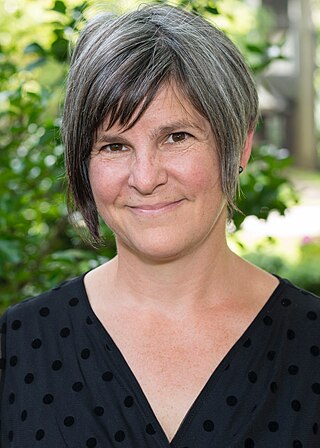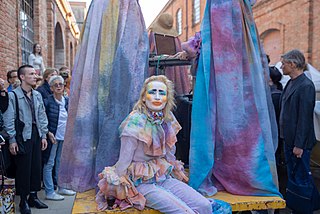Adrian Saxe is an American ceramic artist who was born in Glendale, California in 1943. He lives and works in Los Angeles, California.

Richard "Dick" Marquis is an American studio glass artist. One of the first Americans ever to work in a Venetian glass factory, he became a master of Venetian cane and murrine techniques. He is considered a pioneer of American contemporary glass art, and is noted for his quirky, playful work that incorporates flawless technique and underlying seriousness about form and color.

The Racine Art Museum (RAM) and RAM's Charles A. Wustum Museum of Fine Arts are located in Racine, Wisconsin, U.S. The museum holds the largest and most significant contemporary craft collection in North America, with more than 9,500 objects from nationally and internationally recognized artists. The Racine Art Museum's mission is to exhibit, collect, preserve, and educate in the contemporary visual arts. Its goal is to elevate the stature of craft to fine arts by presenting contemporary crafts alongside paintings and sculptures.

The Estonian Academy of Arts is the only public university in Estonia providing higher education in art, design, architecture, media, art history and conservation-restoration. It is based in Tallinn.
Michael Boroniec is an American sculptor who resides and works in Berkshire County, Massachusetts.
Sonja Blomdahl is an American blown glass artist.
Louise Hindsgavl is a Danish artist who works in ceramic sculpture, porcelain, and stoneware.
Beth Lo in Lafayette, Indiana is an American artist, ceramist and educator. Her parents emigrated from China.

Beth Lipman is a contemporary artist working in glass. She is best known for her glass still-life compositions which reference the work of 16th- and 17th-century European painters.

Kris Lemsalu is a contemporary artist based in Tallinn, Estonia and Vienna, Austria. She studied art at the Estonian Academy of Arts, the Royal Danish Academy of Fine Arts, and the Academy of Fine Arts Vienna. Eccentric with color and material, she uses props, costumes, and other natural materials to portray her artwork. In these installations, Lemsalu sculpts an installation that "gives birth to a world of shamanic force, visionary weirdness, and collective revival." By playing with traditions, Lemsalu blurs the origin and scenically removes their dogma. She avoids "concrete labeling, simultaneously showing us the absurdity of as well as the effectiveness of rituals. From this collective transformative euphoria emerges a belief in the possibility of human redemption." "A punk pagan trickster feminist sci-fi shaman, Kris Lemsalu gathers together both collected and crafted objects into totemic sculptures and hallucinatory environments, animated with performances by the artist and her coterie of collaborators;" her work being shown in many places, including Berlin, Copenhagen and Tokyo. In 2015, she participated in Frieze Art Fair New York, where her work Whole Alone 2 was selected among of five best exhibits by the Frieze New York jury.
Paul Dresang is an American ceramic artist and professor at Southern Illinois University Edwardsville. Working mainly with glass, porcelain, and clay, Dresang’s “highly individual, sensuous, salt-fired porcelain forms are decorated with an obsessive amount of detail.” He defines his work primarily as “post-modern fertility pieces".” Dresang aims to create surreal images with ceramics by often focusing on everyday items in his work and by exploring “opposing ideas of constraint and breaking free.”. After receiving his MFA, Dresang has gone on to become a highly sought-after potter. He has presented his work in countless group exhibitions, and is featured in many permanent collections nationally. He is currently located in Edwardsville, Illinois.
Stephen Dixon is a British ceramic artist and Professor Emeritus at Manchester School of Art. He is also a satirist, writer, lecturer and curator. He is known mainly for his use of dark narrative and for using "illustrated ceramics pots as an unlikely platform for social commentary and political discontent." From Renaissance paintings and British politics to pop culture, Dixon draws on a variety of sources to "challenge the status quo and inspire new ways of thinking." His interests include the British satirical tradition, commemorative wares, and the development of socio-political narratives in contemporary ceramics. In 2021 Dixon was awarded the prestigious British Ceramics Biennial AWARD for his installation 'The Ship of Dreams and Nightmares'.
Jack Earl is an American ceramic artist and former teacher, known for drawing inspiration from his home state of Ohio to create rural pieces “with meticulous craftsmanship and astute details… to where you could smell the air, hear the silence and swat the flies.” Although his works hint at highly personal, intellectual, and narrative themes in an almost unsettling manner, Earl is “a self-described anti-intellectual who shuns the art world." He is known particularly for using his trademark format, the dos-a-dos : “This art form is like a book with two stories… the two seemingly incongruent images prompt the viewer to fill in the conceptual gap through poetic speculation.” His work often involves dogs or the character “Bill”, who is said to be a combination of Earl’s father-in-law, himself, and others. The titles to his pieces are typically lengthy, stream-of-consciousness narratives that suggest the folk or rural lifestyle. These are intended to add another dimension to the artwork. His work has received a notable response over his decades-long career, especially since he is regarded as “a master at reminding us that within the events we take for granted are moments of never-ending mystery and wonder.” Earl continues to live in Lakeview, Ohio with his wife, Fairlie.
Richard Shaw is an American ceramicist and professor known for his trompe-l'œil style. A term often associated with paintings, referring to the illusion that a two-dimensional surface is three-dimensional. In Shaw's work, it refers to his replication of everyday objects in porcelain. He then glazes these components and groups them in unexpected and even jarring combinations. Interested in how objects can reflect a person or identity, Shaw poses questions regarding the relationship between appearances and reality.
Linda Threadgill is an American artist whose primary emphasis is metalsmithing. Her metal work is inspired by forms of nature and the interpretations she gleans from the intricate patterns it presents. She explores the foundation of nature to allude to nature and transform it into re-imagined, stylized plants forms.
Kurt Weiser is an American ceramicist and professor. His work—explorations of the relationship between man and nature through narratives rendered in vivid color—are described as "Eden-like." His work has often taken the form of teapots, vases, and cups, though he has recently begun crafting globes as well. Weiser is currently the Regents Professor at Arizona State University's School of Art.

John Parker Glick was an American ceramicist. Though open to artistic experimentation, Glick was most influenced by the styles and aesthetics of Asian pottery—an inspiration that shows in his use of decorative patterns and glaze choices. His experience working with ceramics led him to publish several articles about the craft. In addition to producing pottery, Glick began making "landscape oriented" wall panels during the latter part of his career. Known as "the people's potter," he is primarily remembered for his contributions to art and the field of ceramics.
Chris Gustin is an American ceramicist. Gustin models his work on the human form, which is shown through the shape, color, and size of the pieces.

Sana Musasama is an African-American ceramic and mixed-media artist based in New York City. Her artistic practice parallels her work as an educator and commitment to human rights causes especially the human trafficking of women. Her work has been recognized with numerous awards including an Anonymous Was a Woman Award in 2002, Joan Mitchell Painters and Sculptors Grant in 2013, and was a Studio Museum in Harlem Artist-in-Residence in 1983–84. Musasama is an associate adjunct professor at Hunter College.
Anders Herwald Ruhwald is a Danish-American sculptor. He works primarily in clay, a medium he has been drawn to since he was 15. Ruhwald's work blends references from functional objects to classical sculpture and can take the form of singular objects as well as immersive installations







